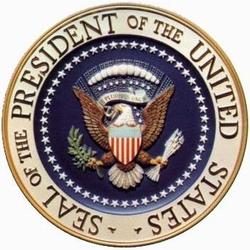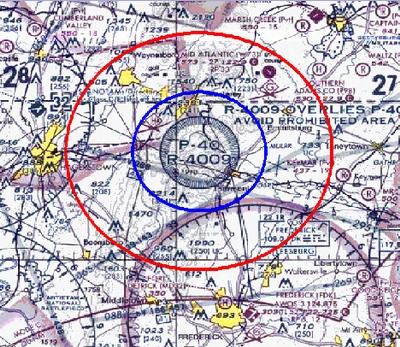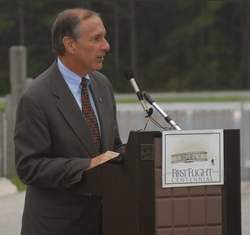Presidential TFR Expansion Will Cause Major Air Traffic And
Economic Disruptions
 The AOPA last week registered a strongly-worded
complaint in response to a Department of Defense request to
increase by some nine-fold the size of restricted airspace
surrounding the President.
The AOPA last week registered a strongly-worded
complaint in response to a Department of Defense request to
increase by some nine-fold the size of restricted airspace
surrounding the President.
In an April 9 letter to Homeland Security Secretary Tom Ridge,
AOPA President Phil Boyer said the DOD request to expand the so
called "Presidential movement" temporary flight restriction (TFR)
area from a 10- to 30-nautical-mile radius around the President
"does not appear to be in response to any specific credible threat,
nor does it address any ongoing security concern posed by general
aviation."
What We Have Hear Is A Failure To Communicate
"Security officials, who have shown little interest in
understanding the general aviation flight environment, are pushing
for this increase (and in fact have been pushing for it for over a
year) simply because they want it, without any justification or
even support from the Transportation Security Administration and
the Federal Aviation Administration," Boyer told Secretary
Ridge.
For Example...
To illustrate the devastating impact the expanded TFR would have
on general aviation and local economies, AOPA cited the example of
the Presidential retreat at Camp David, Maryland, which is
surrounded by the "P-40" prohibited area.
The association noted that at no time in its 61-year history has
Camp David been subject to an airspace restriction of the proposed
size, yet Camp David has been the site of numerous summits and
meetings. Even during the heightened security alerts following the
9/11 attacks, a five-nautical-mile TFR was considered an
appropriate amount of security (last year that was increased to 10
nm without explanation or justification).

A 30-nm-diameter ring around Camp David would cover 11
public-use airports, including AOPA's home field of Frederick,
Maryland, the second busiest airport in the state. It would also
impact Hagerstown Regional Airport, the fifth busiest.
AOPA surveyed the 11 airports and determined that the businesses
based on them would lose $236,124 per day due to the airspace
restrictions. The airports employ some 244 people, are home to
842-based aircraft, and support some 456,000 aircraft operations
per year.
"Expanding airspace restrictions over P-40 would have a
devastating impact on general aviation operators, airports, and the
local economy," Boyer said. "Even if limited operations were
permitted, using the restrictive Air Defense Identification Zone
(ADIZ) operational procedures (requirement for flight plan,
discrete transponder code, and two-way communication), the impact
would be severe.
"The FAA's air traffic system is unable to support these
operational requirements, and as a result, general aviation is 'de
facto' grounded," Boyer told Secretary Ridge.
Don't Change The Rules, Enforce 'Em
 Boyer
argued that pursuing enforcement action against violations of the
current TFRs would be the most important security step officials
could take. Noting that AOPA continues to emphasize to pilots the
importance of avoiding restricted airspace, Boyer pointed out that
incursions into the current P-40 area have decreased significantly
over time.
Boyer
argued that pursuing enforcement action against violations of the
current TFRs would be the most important security step officials
could take. Noting that AOPA continues to emphasize to pilots the
importance of avoiding restricted airspace, Boyer pointed out that
incursions into the current P-40 area have decreased significantly
over time.
AOPA urged Secretary Ridge to "not support the DOD request
because it is excessive and would unnecessarily restrict air
commerce. The current 10-mile Presidential movement TFR provides an
appropriate level of protection, without unnecessarily infringing
on general aviation's freedom of transit."
"I ask that you preserve the airspace around Camp David and
other locations and limit the Presidential movement TFRs to their
current 10-nm-radius size," Boyer (above, right) concluded in his
letter to Secretary Ridge.
With nearly 400,000 members, AOPA is the world's largest civil
aviation organization, dedicated to protecting and preserving the
rights and interests of general aviation pilots. General aviation
consists of all flight activities except military and scheduled
passenger air carrier flights.
 ANN's Daily Aero-Linx (05.06.25)
ANN's Daily Aero-Linx (05.06.25) ANN's Daily Aero-Term (05.06.25): Ultrahigh Frequency (UHF)
ANN's Daily Aero-Term (05.06.25): Ultrahigh Frequency (UHF) ANN FAQ: Q&A 101
ANN FAQ: Q&A 101 Classic Aero-TV: Virtual Reality Painting--PPG Leverages Technology for Training
Classic Aero-TV: Virtual Reality Painting--PPG Leverages Technology for Training Airborne 05.02.25: Joby Crewed Milestone, Diamond Club, Canadian Pilot Insurance
Airborne 05.02.25: Joby Crewed Milestone, Diamond Club, Canadian Pilot Insurance





